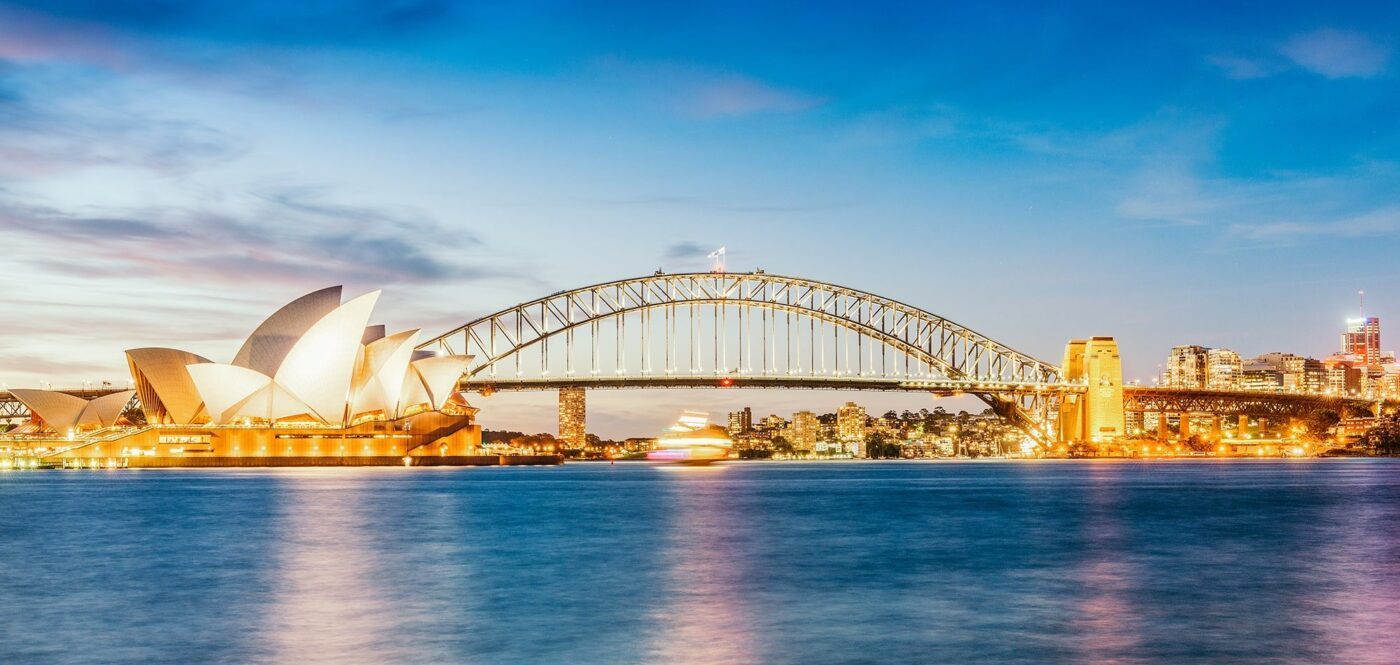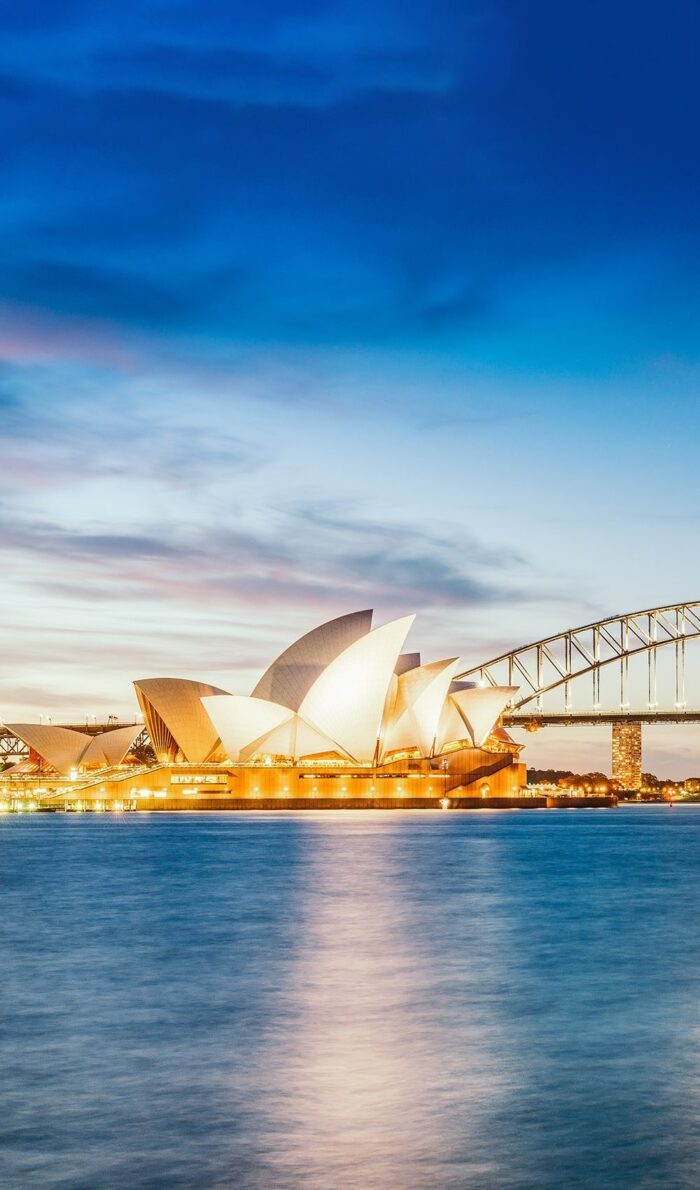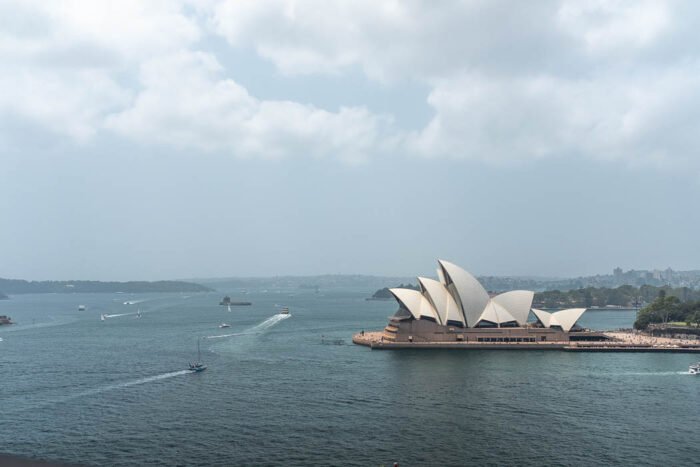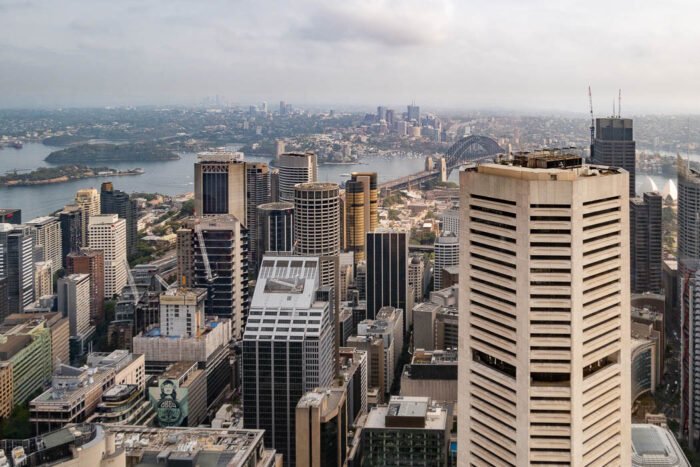

Sydney Travel Guide
Our best tips for first-timers
Our posts about Sydney
Our Sydney Travel Guide
Getting to Sydney
Kingsford Smith International Airport is located about 10 kilometers south of the city center.
There are several direct flights to Sydney from the US, Asia, and the Middle East, plus a couple from Canada, Chile, and South Africa. Travelers from Europe have to layover at one of the major transport hubs, e.g. in Dubai.
Domestically, there are numerous flights connecting Sydney to the rest of Australia. The route between Sydney and Melbourne is one of the busiest in the world.
Getting into town from Sydney Airport
The airport is very well connected to downtown Sydney by public transport.
The fastest way to get to the city center is by train. Depending on your destination, the journey takes between 12 minutes (to Central Station) and 30 minutes (to Kings Cross). It takes a good 20 minutes to get to the center of the Central Business District (Circular Quay or Wynyard Station).
The fare is A$19.40. You don’t need a ticket, just hold your contactless credit card up against the card reader and hop on. If you don’t have a credit card, you’ll need an Opal Card. For more on this, just scroll down to the section on public transport.
Withdrawing money and paying in Sydney
The currency in Australia is the Australian dollar (A$). The conversion rate is about €0.70 / £0.60 / $0.70 to A$1.
Most payments in Sydney are cashless, so there’s no need to withdraw any money. We spent two weeks in Sydney and paid for everything by card. It’s quick and easy because contactless payment is available everywhere and card readers are much faster than back home in Germany.
If you feel more comfortable with cash, there are plenty of ATMs around town. Depending on the bank, you’ll be charged an additional fee of about A$2-5 per withdrawal.
Still, you should always have a credit card on you, since cash is no longer king in Sydney. About 80 to 90% of stores and restaurants will grudgingly accept cash payments, but many will just straight-up refuse.
Travel expenses in Sydney
Sydney is not a cheap destination. Room rates are generally high and alcohol at bars is ludicrously overpriced.
Food can be expensive too, but it doesn’t have to be. If you eat at casual restaurants or food courts, prices are still a little higher than in Europe or the US, but at least not by much.
Here’s an overview of selected prices to give you a general idea how much things cost in Sydney:
Flight to Sydney: A$1,000 to 2,000 (e.g. from Europe / North America)
Room in a good mid-range hotel: A$250-400 per night
1.5-liter bottle of water: A$1-3
Coffee: A$4-6
Public transport: $A3-5 per journey
Dining at a simple restaurant: A$15-25 per person
Dining at a food court or food truck: A$10-15 per person
What to pack for Sydney
You don’t really need to pack anything out of the ordinary for Sydney. If you’re visiting during the Australian summer, bring a few pairs of shorts and flip flops. That way, you’re guaranteed to blend in with the locals.
If you’d like a few general packing tips, check out our guide on what to pack for city trips.
You’re also going to need a plug adapter for Australia. We always pack a universal travel adapter and a multi-port USB charger, so we’re well-prepared wherever we end up.
You should also remember to bring sunscreen. You can buy some in Australia, but it’s always better to come prepared. The sun in Sydney can be relentless and you shouldn’t go outside without protection.
When to visit & how long to stay
The best time to visit Sydney
Since Australia is in the southern hemisphere, their seasons are the exact opposite of ours. Australian summers coincide with our winters, and vice versa.
Sydney gets pretty warm in general. No matter what time of year you travel to Sydney, you won’t find yourself complaining about the weather. Unless you like the rain and cold, that is.
Sydney’s summer months from December to March are usually hot and mostly dry. You can wear shorts and flip flops until well into the evening.
The weather in spring (September to October) and fall (April to June) is more unpredictable. Most days are pleasantly warm, but it’s more likely to rain, and it can get pretty chilly in the evenings.
The winter months from July to August are probably the least attractive time to visit Sydney. Temperatures are relatively mild, but it still feels like winter. And since Sydney is a city where the majority of the life takes place outdoors, we would avoid these months.
How long to stay in Sydney
We recommend planning at least 5 full days for your visit. The longer the better, of course. We spent almost two weeks in Sydney and never got bored.
If you’re in a hurry and just want breeze through the main sights, 3 days should be enough. But you’ll be missing out on the opportunity to really experience the city and soak up some of the atmosphere.
Guidebooks for Sydney
If you like taking a printed guidebook on your journeys, you can’t go wrong with Lonely Planet Sydney.
But then again, you can just as easily bookmark this guide for all the most important information and tips for your trip to Sydney.
Getting around in Sydney
The best way to get from A to B in Sydney is via public transport. There are trains (Sydney Trains), a metro line, light rail, buses, and ferries.
Opal Card vs. paying with credit card
Sydney is the first city we’ve been where you don’t need a ticket, you can just pay for every trip with your credit card.
All you need is a contactless credit card – one per person. So if there’s two or more of you, you’ll each need your own card.
If you don’t have a credit card, you’ll need an Opal Card, which is available at all major stations or from retailers all around town. The Opal Card works as a ticket for all public transport in and around Sydney, including trains, buses, light rail services, the metro, and even ferries.
The card itself is free, but you have to top up at least A$20 (or A$10 when topping up online). Then you can use up your balance ride by ride.
Every time you board a vehicle, hold your Opal Card or credit card up against the reader, and then do the same again when you get off. The exact fare for your journey will be charged to your card.
You can always top up your card at an Opal terminal or a Transport Information counter at one of the stations. Your balance never expires, so you can hold on to your Opal Card until your next visit.
The price per journey depends on the distance traveled, the type of transport (e.g. bus or train), and the time of day. It’s cheaper outside of peak hours and on weekends. A single journey usually costs between A$2 and A$5.
Also, there’s a maximum daily fare of A$16.30, regardless of how much you travel after that. Once you hit the cap, your card won’t be charged any further.
That can be a really good deal if you’re staying a bit further out. For example, the ferry to Manly costs A$10 each way. So after you deduct the cost of a return trip to Manly, you can virtually ride for free for the rest of the day.
On weekends and public holidays, the fare cap is only A$8.15, so that’s a great time for outings. And if you’re going to be in Sydney for a whole week, your fare is capped at A$50. But that only applies to an actual calendar week from Monday to Sunday, not 7 consecutive days.
Hop-on, hop-off buses in Sydney
Hop-on, hop-off sightseeing buses are another way to get around Sydney. As the name suggests, you can hop on and off at any of the 20 stops for a day or two and enjoy a scenic view of the city from the open-top double-decker buses during the ride.
There are two bus routes available. The red line covers the highlights in the center of Sydney, the blue line goes to the beach in Bondi. Hop-on, hop-off buses are a good option for your first few days in Sydney to give you a feel for the city.
Our tip: Buying tickets online is cheaper than purchasing them on-site.
Book hop-on, hop-off bus tickets for one or two days starting at A$59
Can you drink tap water in Sydney?
Yes, tap water in Sydney is safe to drink.
However, the water is pretty heavily chlorinated. It’s completely harmless, just not to everyone’s taste.
There are also quite a few water fountains in the city where you can fill up your water bottles for free. If you’re lucky, you might chance upon a fountain with filtered water that tastes slightly better. If not, it has the same lingering chlorine taste as everywhere else.
Any more questions?
That’s the end of our practical travel guide to Sydney. Do you have any questions or tips of your own that you’d like to share? Then we look forward to hearing from you in the comments!


